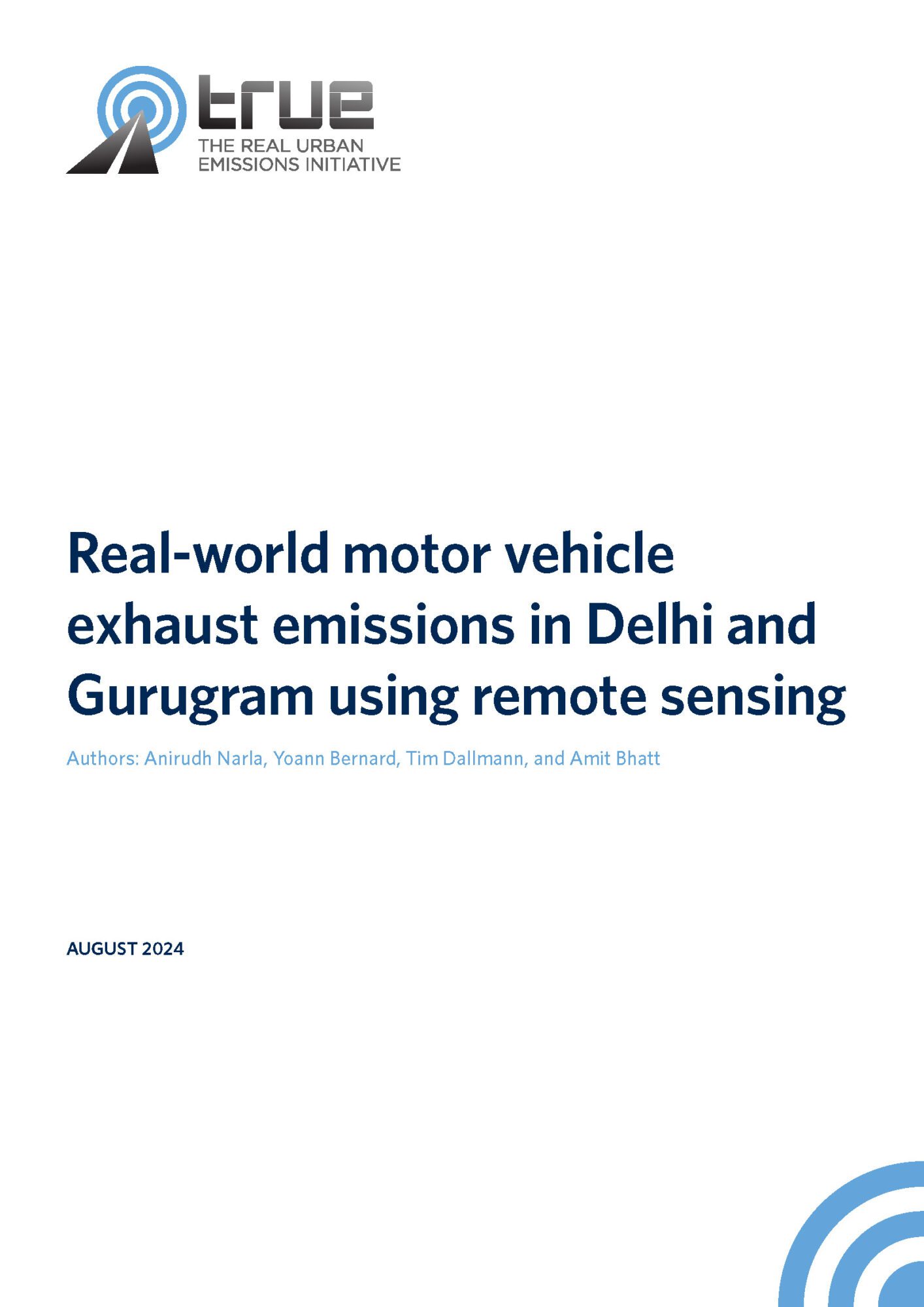Real-world motor vehicle exhaust emissions in Delhi and Gurugram using remote sensing
Blog
Need to read vehicular emissions right in India’s National Capital Region
This piece originally appeared in the Hindustan Times.
As October approaches, the annual discourse on the air quality crisis in Delhi National Capital Region (NCR) is set to begin. Apart from meteorological considerations over which we have little control, increasing pollution from anthropogenic activities, particularly vehicular emissions, continues to worsen the problem. But this year, there’s something new: The Real Urban Emissions (TRUE) Initiative, founded by the FIA Foundation and the International Council on Clean Transportation (ICCT), worked with authorities in Delhi and Gurugram to complete a comprehensive remote sensing study that measured over 100,000 vehicles across 20 sites. The data presented in our new report is key information that reveals ways to help tackle the problem.
Importantly, remote sensing technology is not new to India. Kolkata pioneered its use in 2009, and government agencies like the International Centre for Automotive Technology conducted pilot programs in 2017. The National Green Tribunal has also advocated to the Central Pollution Control Board for its implementation since 2015, but the technology has yet to be widely adopted. It’s encouraging, then, that the Supreme Court of India recently reiterated its 2018 and 2019 directives to the Ministry of Road Transport and Highways (MoRTH) to implement remote sensing technology in the NCR.
The problem of vehicle emissions
India is the world’s third most-polluted country and home to the most-polluted capital, according to the World Air Quality Report 2023 by IQAir. Over the past 25 years, various agencies, including the Supreme Court, the National Green Tribunal, and MoRTH, have implemented numerous measures to curb emissions from road transport. Despite these efforts, the rising number of vehicles has thus far largely offset the progress made. But there was a significant leap in terms of vehicle emissions in April 2020 when India transitioned directly from Bharat Stage (BS) IV to BS VI emission standards.
The current vehicle emissions testing regime is comprised of two parts primarily. The first is the type-approval stage, where the government grants (or not) approval for a manufacturer to introduce a tested model into the market. The second is the widely known in-use compliance test, the pollution-under-control certification (PUCC); this is needed periodically and applies to every internal combustion engine vehicle on the road. There are limitations to both. The type-approval test, which now incorporates real-driving emissions testing using a portable emissions measurement system, is expensive for mass-scale monitoring. The PUCC test, meanwhile, is conducted in idle conditions and doesn’t capture key transport pollutants like nitrogen oxides (NOx) and particulate matter.
To ensure consistent vehicle performance in real-world conditions, monitoring and enforcement programs can supplement periodic emissions inspections. Remote sensing technology can non-intrusively screen tailpipe emissions on a large scale and help identify highly polluting vehicles.
The TRUE Initiative helps cities worldwide develop air quality and climate policies using independent real-world vehicle emissions data. The study in Delhi and Gurugram, conducted from December 2022 to April 2023, measured exhaust emissions of NOx, carbon monoxide (CO), hydrocarbons (HC), and ultraviolet (UV) smoke, a proxy for particulate matter, from two- and three-wheelers (3W), private cars (PC), taxis, light goods vehicles (LGV), and buses.
Key findings from the new data
The analysis revealed that India’s leap from BS IV to BS VI norms led to significant reductions in tailpipe emissions across all vehicle types. This underscores the benefit of promoting cleaner technologies and stricter regulations, and points to the potential of introducing BS VII norms in the future. The study also found disparities in emissions across different vehicle segments, with commercial vehicles like light goods vehicles, taxis, 3Ws, and buses emitting substantially more than private vehicles.
In comparing captured real-world emissions with laboratory limits (the type-approval limits) set by MoRTH, we found that real-world emissions can be multiple times higher (15–25 times higher in a few cases). While the vehicles in the study are not required to meet lab limits on the road, this significant difference emphasizes how performance that qualifies for type-approval certification does not reflect the ultimate impacts on air quality and human health. As shown in the figure, even the BS VI vehicles, which were the cleanest of those measured, had higher emissions during real-world operations.
The path forward
The NCR has seen a major shift towards compressed natural gas (CNG) as an alternative to traditional petroleum fuels. This was done largely to reduce particulate matter emissions. However, as that figure shows, this study’s data challenges the perception of CNG as a “clean” fuel solution. High NOx emissions are particularly concerning because NOx contributes to the formation of secondary particulate matter and ozone. Thus, relying on CNG as a transitional step towards zero-emission vehicles may not be suitable for regions like Delhi and Gurugram, where air quality is already severely compromised.
It’s also clear from the study’s results that PUCC limits do not reflect real-world emissions. This underscores the need to complement PUCC tests with real-world monitoring technologies. The Automotive Industry Standard (AIS) 170 standard, in draft since 2020, needs to be finalized and notified by MoRTH to enable effective use of remote sensing. Our report suggests a few key changes to strengthen the current draft.
Finally, accelerating the transition to zero-emission vehicles, especially in commercial segments, is crucial to combat vehicular emissions in Delhi NCR. Several policy options are available to achieve this, including implementing a supply mandate for zero-emission vehicles and establishing low-emission zones to complement existing policies. The Commission for Air Quality Management is well positioned to lead this effort in the NCR.
Authors
Related Publications

REAL-WORLD MOTOR VEHICLE EXHAUST EMISSIONS IN DELHI AND GURUGRAM USING REMOTE SENSING
Analyzes real-world emissions from vehicles in India’s National Capital Region through the TRUE Initiative.



